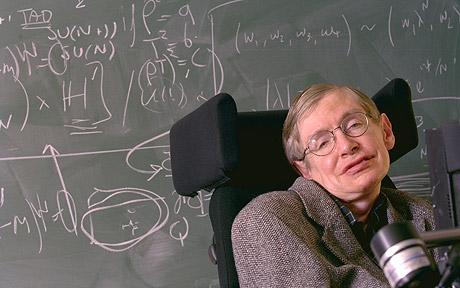New attempts to convert Prof. Stephen Hawking’s brainwaves into speech
US scientist Prof. Philip Low is to unveil details of work on the brain patterns of Prof. Stephen Hawking which he says could help safeguard the physicist’s ability to communicate.
Prof. Philip Low said he eventually hoped to allow Prof. Stephen Hawking to “write” words with his brain as an alternative to his current speech system which interprets cheek muscle movements.
Prof. Philip Low said the innovation would avert the risk of locked-in syndrome.
Intel is working on an alternative.
Prof. Stephen Hawking was diagnosed with motor neuron disease in 1963. In the 1980s he was able to use slight thumb movements to move a computer cursor to write sentences.
His condition later worsened and he had to switch to a system which detects movements in his right cheek through an infrared sensor attached to his glasses which measures changes in light.
Because the nerves in his face continue to deteriorate his rate of speech has slowed to about one word a minute prompting him to look for an alternative.
The fear is that Prof. Stephen Hawking could ultimately lose the ability to communicate by body movement, leaving his brain effectively “locked in” his body.
In 2011, he allowed Prof. Philip Low to scan his brain using the iBrain device developed by the Silicon Valley-based start-up Neurovigil.
Prof. Stephen Hawking will not attend the consciousness conference in his home town of Cambridge where Prof. Philip Low intends to discuss his findings.
A spokesman said: “Professor Hawking is always interested in supporting research into new technologies to help him communicate.”
The iBrain is a headset that records brain waves through EEG (electroencephalograph) readings – electrical activity recorded from the user’s scalp.
Prof. Philip Low said he had designed computer software which could analyze the data and detect high frequency signals that had previously been thought lost because of the skull.
“An analogy would be that as you walk away from a concert hall where there’s music from a range of instruments,” he said.
“As you go further away you will stop hearing high frequency elements like the violin and viola, but still hear the trombone and the cello. Well, the further you are away from the brain the more you lose the high frequency patterns.
“What we have done is found them and teased them back using the algorithm so they can be used.”
Prof. Philip Low said that when Prof. Stephen Hawking had thought about moving his limbs this had produced a signal which could be detected once his algorithm had been applied to the EEG data.
He said this could act as an “on-off switch” and produce speech if a bridge was built to a similar system already used by the cheek detection system.
Prof. Philip Low said further work needed to be done to see if his equipment could distinguish different types of thoughts – such as imagining moving a left hand and a right leg.
If it turns out that this is the case he said Prof. Stephen Hawking could use different combinations to create different types of virtual gestures, speeding up the rate he could select words at.
To establish whether this is the case, Prof. Philip Low plans trials with other patients in the US.
The US chipmaker Intel announced, in January, that it had also started work to create a new communication system for Prof. Stephen Hawking after he had asked the firm’s co-founder, Gordon Moore, if it could help him.
It is attempting to develop new 3D facial gesture recognition software to speed up the rate at which Prof. Stephen Hawking can write.
“These gestures will control a new user interface that takes advantage of the multi-gesture vocabulary and advances in word prediction technologies,” a spokeswoman said.
“We are working closely with Professor Hawking to understand his needs and design the system accordingly.”

